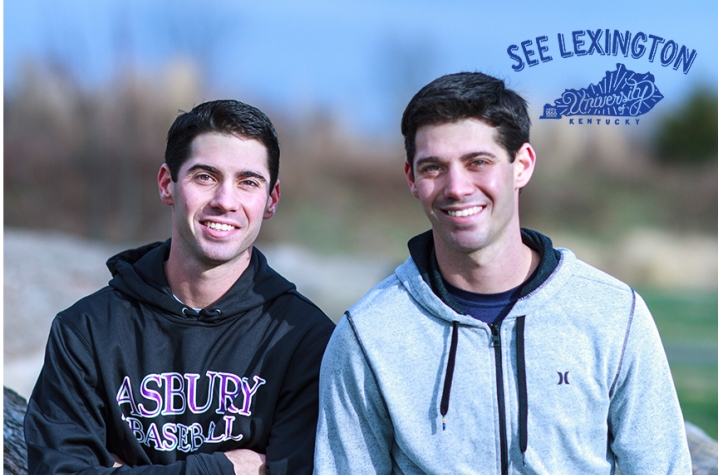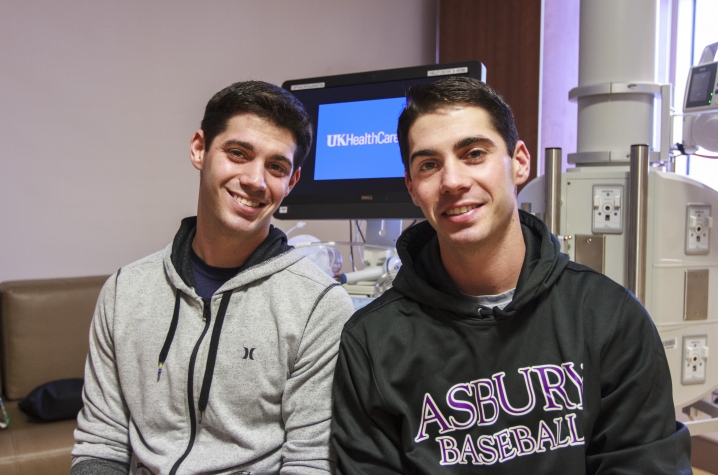These Twins Weren't Identical (But Only for Eight Weeks)
LEXINGTON, Ky. (Feb. 3, 2015) -- Jon Wes and Gardner Adams are 26-year old identical twins in every way. It's nearly impossible to tell them apart. Though a few people claim Jon Wes smiles more than Gardner, their mannerisms and speech are identical.
Widely proclaimed as "basically good kids," Jon Wes and Gardner didn't play many of the usual identical twin tricks on people, though they admit to switching team jerseys once or twice. Gardner says they've been pretty much attached at the hip since birth. "We both share a love of God and baseball," he says.
But for eight weeks, they weren't identical.
An accomplished shortstop and pitcher, Jon played for Asbury College and now coaches there. Gardner, who also played baseball for Asbury, was drafted by the Atlanta Braves. In top physical condition, both are avid runners, clocking 15-20 miles a week.
So it was a shock when one day last summer, Jon Wes drove to the Lexington Arboretum for his 8-mile run -- but left in an ambulance. [youtube]
That evening, he began his usual route. But for the first time ever, he turned left instead of right -- a decision that saved his life.
Six miles into his route, Jon collapsed. His heart had stopped beating -- known as "sudden cardiac arrest." Because he had turned left that day, he collapsed in the middle of a concert. Some medical professionals in attendance began performing "Bystander CPR" to keep Jon alive.
"Jon was very lucky to collapse where he did," says Dr. Alison Bailey, director of Prevention and Cardiac Rehabilitation at the Gill Heart Institute and the cardiologist who cared for Jon during his stay at UK HealthCare. "'Bystander CPR' kept him alive until emergency medical personnel arrived. It's unlikely he would be with us now without it."
An out-of-hospital cardiac arrest victim’s chances of survival double or triple if a bystander is trained in CPR. Unlike traditional CPR, which uses both chest compressions and mouth-to-mouth breathing, Bystander CPR uses only chest compressions to keep blood circulating until emergency crews arrive. "By simplifying the process, it’s easier for people to remember and perform so that they will be less intimidated if they find themselves in an emergency situation," Dr. Bailey explains. "Research has shown that rhythmic chest compressions to the beat of the Bee Gee's tune 'Stayin' Alive' Hands-Only CPR demo video can deliver enough oxygen to keep the brain alive during the time the heart is not functioning."
According to the latest research, even school children can achieve acceptable levels of CPR skills proficiency in 30 minutes or less.
"In fact, many states now require high school students to learn Hands-Only CPR in order to graduate," says Bailey. "Kentucky's legislature is re-considering the bill this spring, and we're hopeful that it will pass this time."
Meanwhile, Jon's family was becoming concerned that Jon hadn't returned home from his run. Gardner met his parents at the Arboretum to look for Jon. Gardner said that at first he wasn't too concerned, since Jon sometimes hung out on a bench after his run, reading the Bible or people watching.
"We split up to search for him, and I was about a half a mile down the path when my phone rang," Gardner said. "When my dad told me what had happened, the run back to the car was the fastest half mile I've ever done."
By the time his family arrived at UK Chandler Hospital, Jon was on a ventilator. To protect Jon's brain from damage caused by a lack of oxygen during his cardiac arrest, Dr. Bailey used a procedure called therapeutic hypothermia, during which Jon was put into a medically induced coma and his body temperature was cooled temporarily. Jon awoke a few days later and has had a complete recovery.
Tests would later confirm that Jon had Brugada Syndrome, a rare genetic disease that can cause ventricular fibrillation (a lethal arrhythmia) of the heart. Sudden cardiac arrest in Brugada Syndrome patients is relatively rare, but the risk is increased if a family member has had an abnormal rhythm.
A team from the Gill Heart Institute implanted a device in Jon's chest that detects abnormal heart rhythms and will attempt to "shock" the heart back to a steady, normal heartbeat if this happens again. It's a miniature version of the paddles doctors use to bring patients back to life in television dramas. Jon will live with this internal cardiac defibrillator for the rest of his life, returning for battery changes and regular follow-up tests.
By then, Dr. Bailey knew that Jon had a twin -- an identical twin. She put Gardner through the same series of tests. He had Brugada Syndrome as well.
Eight weeks after Jon Wes had surgery, Gardner went through the same procedure to implant an ICD.
His first words out of surgery: "Hey mom -- we're identical again."
"God answered a prayer that awful day in June," said Jon. He's learned to appreciate every day instead of worrying about whether he was where he wanted to be or where he "should" be. And both he and Gardner have become advocates for Bystander CPR. "Bystander CPR is what kept me alive, and in a way it saved Gardner's life as well," says Jon.






